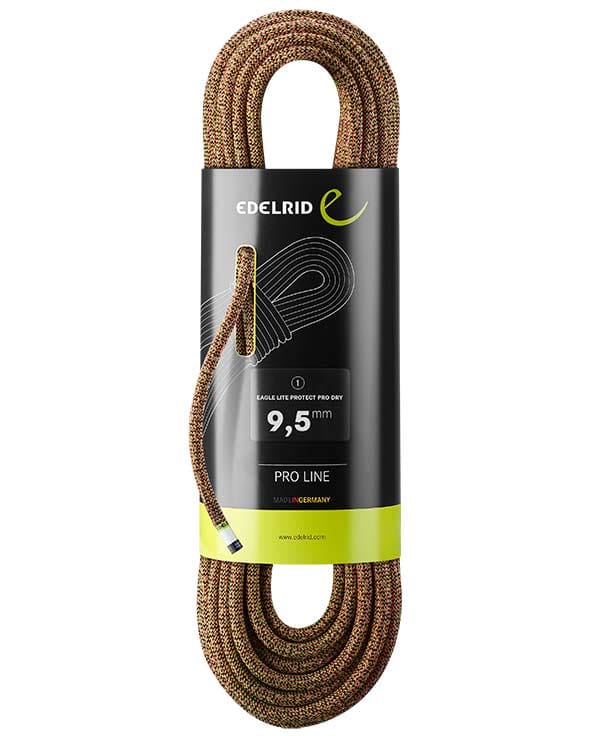Making a climbing rope out of a climbing rope is like the Holy Grail for manufacturers like Edelrid. We visited the Allgäu inventors in Isny to learn more about their understanding of sustainability and innovation and their vision of a closed-loop system.
Isny im Allgäu forms the south-eastern tip of the federal state of Baden-Württemberg. A company has been producing the majority of its products here since 1863, with which all those who prefer to move vertically come into contact: Edelrid.
With products like the climbing rope NEO 3R, which consists of 50% recycled yarn obtained from pre-consumer rope residues, the Allgäu-based company has made a name for itself as an innovative think tank that tries to reduce its ecological footprint. During a visit to the site, we wanted to find out how this balancing act can be achieved if the products produced are not sustainable per se.
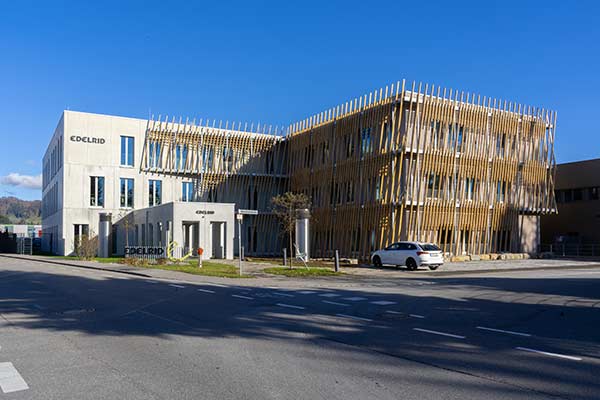
Edelrid, the rope team
Who is Edelrid? And who are the people behind the manufacturing company for ropes, climbing equipment and personal protective equipment? It won't be long before we start getting answers to these questions. The exit to Ravensburger Spieleland has just passed us - Isny is not far away.
The Edelrid family is also playful, if you believe the values on their website: We are a colorful bunch. We are inventors. We are a rope team. It means among other things. It's just after nine when we steer our mobility scooter into the reserved parking space with a charging station. However, there is no electrifying plug-in, the matching adapter has stayed at home.
This shows for the first time what Edelrid means by "We are a rope team". While we are being welcomed by Sales Manager Thomas Schmidt, he texts an employee, who shows up a little later and – as if it were the most natural thing in the world – provides us with his charging cable and charging card.
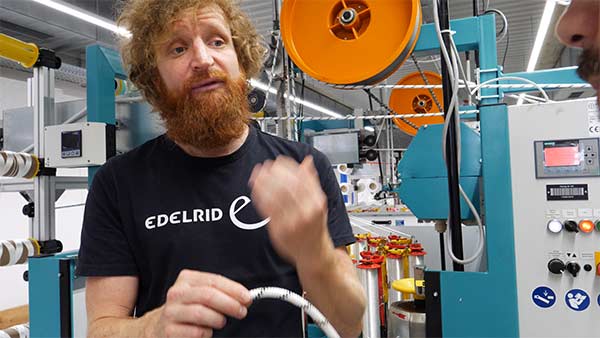
At the heart of Edelrid production
So much in advance: In Isny, people are well aware that they do not manufacture green products. An example of this are the dynamic climbing ropes, which are made of polyamide – or better known under the brand name Perlon.
Martin Schlemmer guides us through the heart of Edelrid: rope production. The head of rope development is a veritable rope guru. His knowledge seems almost inexhaustible and his enthusiasm for the product is reflected in the accuracy with which he explains the individual production steps.
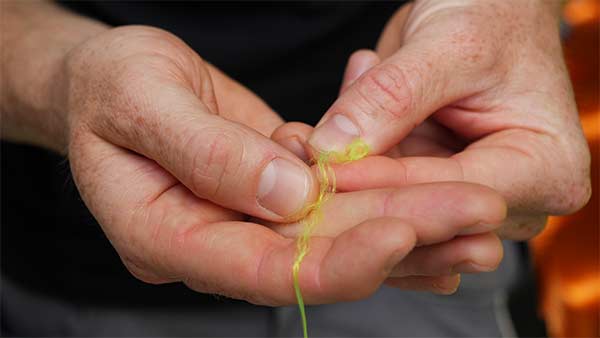
PFC shows the complexity of the concept of sustainability
Using two rolls of yarn that differ only slightly in color, he demonstrates that PFC-free ropes now also meet the high requirements in terms of impregnation. In 2018, Edelrid made the big leap: The world's first PFC-free impregnated climbing rope that meets the criteria of the UIAA water repellency standard.
With a pipette, Martin Schlemmer first dribbles a few drops onto the first roller, where they are drawn up in a matter of seconds. On the second, the water rolls off, the drops remain. The process that Edelrid uses for its PFC-free, impregnated ropes is based on nature and tries to imitate the properties of the lotus plant as best as possible.
Philippe Westenberger is responsible for the entire product range at Edelrid, as well as for development. When he talks about sustainability, his main concern is to consider and improve the entire process from the raw material to the end product. "At PFC we only talk about one dimension of sustainability, namely toxins for humans and animals." An example that makes it clear how complex the issue of sustainability actually is.
On the one hand, he welcomes reports on sustainability. On the other hand, he has respect for blowing the same horn as those who only do greenwashing. As an example, Philippe Westenberger cites communication about PFC-free ropes:
“Many companies advertise PFC-free ropes, but hide the fact that they are not impregnated. That's the same as saying: Here I have a vegetarian apple."
Philip Westenberger
Innovation: More than just a buzzword
During our tour of the sacred Edelrid catacombs, we also pass through what at first glance appears to be a rather inconspicuous room. Various devices and machines are in it. One of them, an in-house design to test the cut resistance of climbing ropes, symbolizes Edelrid's approach to innovation.
Edelrid affords its own innovation department, which can really spin itself out compared to product development. The boundaries between the two departments are often fluid, explains Philippe Westenberger, adding that the topic of cut resistance is a good example of this synergy. «Everything related to the rope was developed in the rope department. The machine for testing the cut resistance was built with the innovation department.»
Eagle Lite Protect Pro Dry
Edelrid spent a total of six years tinkering with the machine for testing cut resistance. The first dynamic single rope with built-in cut protection came out in 2019: Swift Protect Pro Dry with a diameter of 8,9 mm.
This year, Edelrid is launching a brand new rope with cut protection, the Eagle Lite Protect Pro Dry 9,5 mm, which is even better suited for sport climbing thanks to improved handling.
Because even if rope tears due to excessive load application almost never occur with modern climbing ropes, there are always accidents in which sharp objects cut through the rope.
"The problem was that there were no reliable test methods for cut resistance up to that point," explains Philippe Westenberger.
So Edelrid set about developing its own test procedure that could be used to quantify cut resistance. In this way, one learned to understand which parameters in the rope have a positive influence on cut resistance.
The enthusiasm with which Philippe Westenberger talks about the umpteen evenings at the cutting machine reminds us once again of the values on which people build here in Isny: We are inventors. In particular, because he didn't do this on working hours, but because he "was so keen on it."
At Edelrid, if you want, you can
On our sightseeing tour with rope guru Martin Schlemmer, we meet different people who completely identify with their work. What is exciting is that they are not always thoroughbred climbers, as you might expect from a mountain sports brand.
In Edelrid's in-house testing laboratory, for example, there is a seasoned gentleman who has never assembled the climbing finches himself, but is all the more enthusiastic about detailed figures on the physical properties of a climbing rope.
Or then there's Gisela from ready-made clothing, who lets up to 18 kilometers of rope run through her hands every day and senses the tiniest inequalities and deviations. A job that she has been doing for 30 years and for which even the Edelrid inventors have not yet been able to develop an adequate machine.
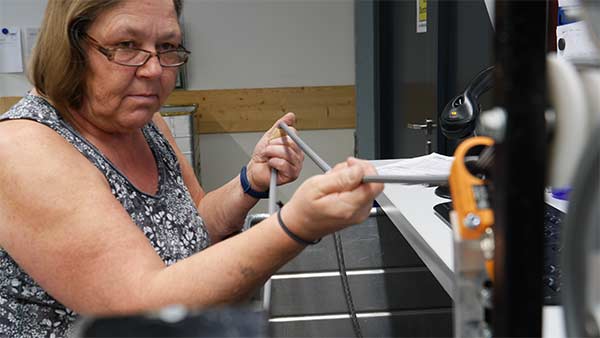
Product manager Philippe Westenberger names various reasons that have kept him here at Edelrid for the past eight years. On the one hand, the many people who shared his passion for the products. On the other hand, the freedom: "You have the opportunity to try out a lot and do it yourself."
After the lunch break, Managing Director Vitus Wuhrer joins in via video call. The 30-year-old is currently on a business trip in Asia, meeting important suppliers and personalities from the industry. We also talk to him about the spirit at Edelrid.
"Once you've belonged to the Edelrid family, it's not easy to get rid of it."
Vitus Wuhrer
What sounds like the subtle threatening gesture of a mafia boss is supposed to mean that Edelrid puts his trust in anyone who wants to steal something. “We have a large playing field for those who would like to make a difference.”
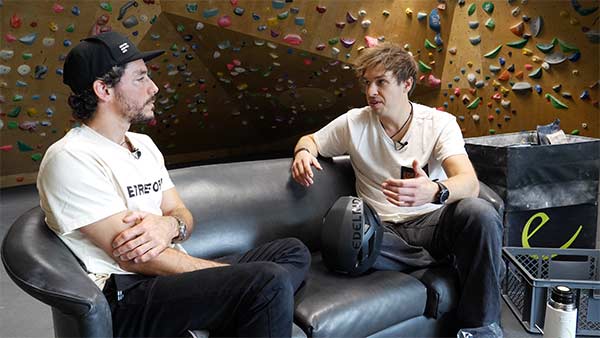
A helmet made from scraps of rope
Back to the rope production tour. Again and again we notice large containers on rollers in which colorful pieces of rope are slumbering. Philipp Westenberger speaks of so-called pre-consumer ropes, i.e. waste that occurs during the production process.»
After many years of development work, this results in new products such as the shell of the climbing helmet Zodiac 3R. The fact that Edelrid manufactures personal protective equipment, i.e. products that people entrust their lives to, does not make things any easier.
"Normally, material loses some of its performance with each recycling process."
Philip Westenberger
"Normally, material loses some of its performance with each recycling process," explains Philippe Westenberger. This is partly the reason why it is so difficult to make a completely new rope from leftover rope.
The head of product and development reveals without revealing trade secrets. "The magic happens between the granulate and the re-granulate."
The yarn is chopped and cleaned, the granules are formed. In the next step, this becomes re-granulate, which is melted and finally spun back into yarn. Not only new ropes are made from leftover ropes, but also other new products, such as climbing helmets.
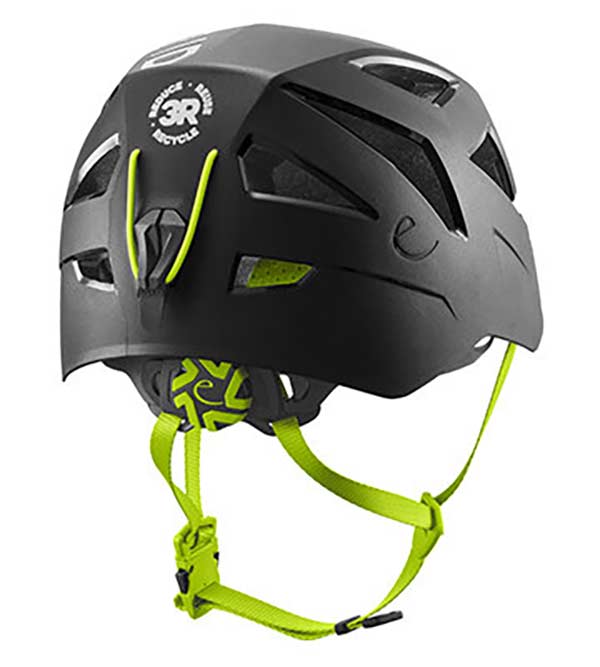
Reduce, Reuse, Recycle
At least since the song by singer-songwriter Jack Johnson, the concept of reduce, reuse and recycle has been known to many. However, in the eyes of Philippe Westenberger, what is given far too little attention is the sequence.
"Recycling is the worst of the three Rs, because then the damage has already been done." If you reuse it, you can at least give the damage a second meaning.
"But the very best is of course the first R, i.e. the reduction, because then the damage does not occur in the first place."
Philip Westenberger
Circulatory System: The Holy Grail
These thoughts from Philippe Westenberger lead us back to Edelrid's understanding of sustainability and her intensive examination of the subject. "I find it difficult to talk about sustainability when we manufacture products that are not sustainable in themselves," says Vitus Wuhrer from faraway Asia. Edelrid is much more likely to try to reduce the company's own footprint.
«I find it difficult to talk about sustainability when we make products that are not sustainable in and of themselves»
Vitus Wuhrer
One person hired to keep an eye on Edelrid is Corporate Social Responsibility Manager Sarah Lenz. The challenge of her work sometimes lies in working with the various departments to find an external image that does not paint a glorified image of sustainability. Rather, it is about reconciling the actual efforts to reduce one's own footprint with the fact that the products are ultimately not "green".
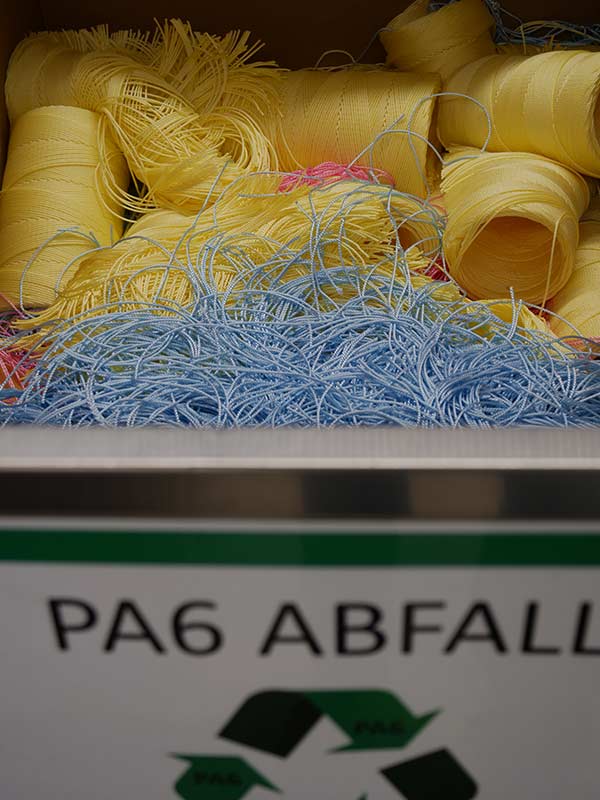
Those responsible for the various areas agree on the scientific approach when it comes to sustainability: If Edelrid says that something is sustainable, then you at least want to know why exactly it is sustainable from the company's point of view.»
"If we ever succeed in processing ropes back into ropes, then we can finally start talking about sustainability."
Vitus Wuhrer
With a view to the future, the inventors from Isny are striving for a circulatory system in which a rope is processed back into ropes. “A first, important milestone has already been reached with the NEO 3R mentioned at the beginning. There are still a few challenges in the way of scaling this approach to all ropes or other products and the corresponding recycling of post-consumer rope waste, i.e. ropes that have already been used by the end customer.
If this However, should it succeed, one can finally start talking about sustainability, says the young managing director Vitus Wuhrer. "But as long as we still have to use up raw materials, it's a very critical issue."
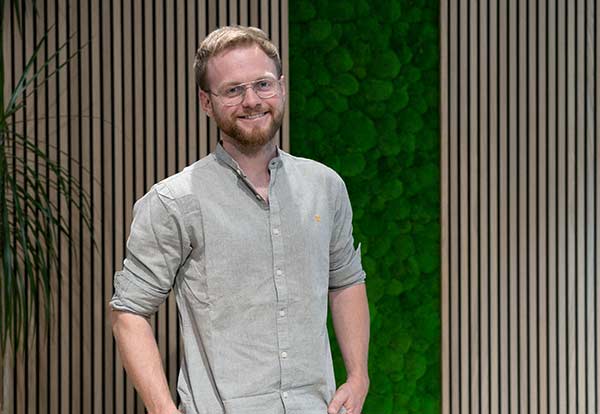
thoughts on the way home
As the afternoon slowly gives way to evening, we drive back to Switzerland. The car freshly charged, the heads full of impressions. Somehow, it seems to us, Edelrid relies heavily on understatement. Is it because of the geographic proximity to Switzerland? Difficult to say.
We got the impression that everyone at Edelrid is convinced that it is no longer possible to carry on as before and that something has to change. Not only at corporate level, but also privately.
In this regard, we review an anecdote from Sales Manager Thomas Schmidt and have to smile. It is about Martin Schlemmer, who resigns from driving with iron consistency. Even in the worst winter storm weather, he couldn't be persuaded to come along and slid home on his bike over the snow-covered streets.
That might interest you
- This rope is cut-resistant than all others: the Edelrid Swift Protect Pro Dry
- Safe climb despite weight difference: With the ohm of Edelrid
- Combines comfort and performance: the Spirit climbing shoe from Red Chili
Do you like our climbing magazine? When we launched LACRUX, we decided not to introduce a payment barrier. It will stay that way, because we want to provide as many like-minded people with news from the climbing scene.
In order to be more independent of advertising revenue in the future and to provide you with even more and better content, we need your support.
Therefore: Help and support our magazine with a small contribution. Naturally you benefit multiple times. How? You will find out here.


